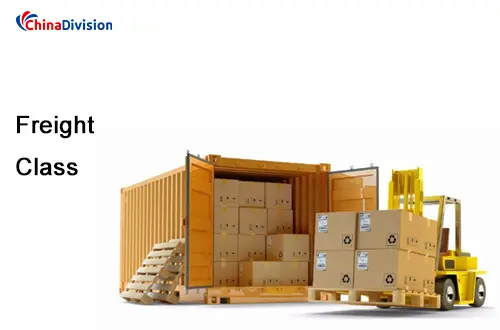Decoding Freight Class: Reducing International Logistics Costs
Freight class is a crucial factor in determining shipping costs, yet it's often overlooked by international trade companies. When preparing to ship goods from China to global markets, are you confused: Why do freight quotes for the same volume of goods vary so dramatically? Why do logistics providers constantly ask for specific details?
Table of Contents
- What is freight class?
- What is the National Motor Freight Classification (NMFC)?
- What is the difference between the NMFC code and freight class?
- Four Core Factors Determining Freight Class
- How does freight class directly affect your international shipping costs?
- FAQ
- How does Chinadivision help with freight classification?
In cross-border logistics, this article will provide an in-depth analysis of freight class from the perspective of international freight service providers, addressing common pain points for B2B and e-commerce sellers, and provide practical solutions.
What is freight class?
Freight class is a numerical standard between 50 and 500 that uniformly categorizes all types of freight in less-than-truckload (LTL) shipments. This system, derived from the US National Motor Freight Classification (NMFC), has become the pricing cornerstone for LTL shipments in North America and many international markets.

What is the National Motor Freight Classification (NMFC)?
The NMFC is a comprehensive system that assigns freight classes and specific NMFC codes to commodities based on their assessed shipping characteristics. These codes and classes help carriers and shippers standardize shipping costs, processes, and handling requirements for thousands of different products.
An NMFC code uniquely identifies a single commodity. Each NMFC code corresponds to a specific freight class, which carriers use to calculate shipping costs.
Think of the NMFC code as the product SKU for a shipment, while freight classes group freight classes with similar shipping characteristics.
The National Motor Freight Classification (NMFC) categorizes less-than-truckload (LTL) shipments into 18 classes (Classes 50-500). This system quantifies freight characteristics to establish a unified benchmark for global freight pricing, making it particularly useful in cross-border trade between China and the United States.
Simply put, a freight class acts like a shipment's "identity card," telling carriers (trucking companies) how difficult and risky it is to transport your shipment. Lower class numbers (e.g., 50-100) indicate easier shipping and lower freight rates. Higher class numbers (e.g., 300-500) indicate more challenging shipments and higher freight rates.
Typical Applications:
3C electronics exports (e.g., monitors are classified as Class 92.5);
Furniture cross-border e-commerce (sofas are typically Class 175);
Industrial parts shipping (steel bars are Class 50);
What is the difference between the NMFC code and freight class?
The NMFC code is the "name" of the shipment. It is a numerical and alphanumeric code that corresponds to a precise description of a specific product in the National Motor Freight Classification. For example, a specific model of wooden furniture may have its own unique NMFC code.
The freight class is the "character score" of the shipment. It is a number calculated based on the product characteristics described in the NMFC code, representing the freight rate.
The relationship between the two is: first, the NMFC code is determined by the cargo's attributes, which then determines the corresponding freight class. The two work together to determine your shipping rate.
Four Core Factors Determining Freight Class
Freight class isn't assigned arbitrarily; it's determined by the following four scientific factors:
Density
This is the most critical factor. The formula is: Density = Weight (pounds) / Volume (cubic feet). High-density cargo (such as metal parts) is typically assigned a lower class (e.g., 50/55/60) because it's stable and easy to handle. Low-density cargo (such as foam plastics and empty boxes) is assigned a higher class (e.g., 400/500) because it takes up a lot of truck space but has little value.
Density Pitfalls: Ignoring packaging thickness can lead to misclassification (e.g., using thicker foam boxes).
Stackability
Is the cargo easy to stack? Does it have an irregular shape, sharp protrusions, or hazardous properties? Cargo that is difficult to stack safely receives a higher class because it wastes space in the truck bed.
Odd-shaped cargo is calculated based on the maximum dimensions (e.g., round equipment is calculated based on the outer dimensions of a square).
Handling Difficulty
Does the cargo require special handling? For example, is the cargo overweight, overlong, fragile, requires constant temperature, or requires delicate equipment with white glove service? The more complex the handling, the higher the class.
Easy to handle: Pre-packaged foods (Class 60)
Difficult to handle: Heavy machinery requiring forklift loading and unloading (Class 300+)
Liability and Value
Is the cargo fragile, perishable, vulnerable to theft, or high-value? High-value or high-risk cargo carries a higher risk of claims, so carriers charge higher premiums by increasing the class to cover insurance costs.
High-risk: Glass products (Class 250), lithium batteries (requiring dangerous goods certification)
Low-risk: Metal raw materials (Class 50-60)
Insurance linkage: Class 400 premiums are typically 300% higher than Class 50.
How does freight class directly affect your international shipping costs?
- Base Rate Multiplier Effect
Class 50: Base rate $1.2/lb
Class 500: Rates up to $8.5/lb (a 7x difference)
E-commerce Hot Product Analysis:
Phone Cases (Class 150): $2.8/lb
Ceramic Tableware (Class 250): $5.2/lb
- Surcharge Triggering Conditions
Minimum Charge Threshold: Class 300+ shipments may trigger a minimum charge of $150+
Dimensional Weight Ratio: When the volumetric weight of a shipment exceeds its actual weight, the dimensional weight is used for fare calculation (formula: length × width × height ÷ 139).
- Combined Costs of Intermodal Transportation
In LTL (Long-Term Transport) shipping, shipments from multiple shippers share a single truck. Carriers need a fair way to share costs. Freight class is the yardstick of fairness. Shipping companies typically use the following pricing formula: Freight = Rate × Freight Class.
This means that even if two shipments have the same weight and volume, a mechanical part with a Class 65 and furniture with a Class 250 could have a freight rate that differs several times. Misdeclaring freight class is the most common cause of unexpected freight rate increases and even hefty penalties (re-weighing and re-classing).
FAQ
Do I need to look up the NMFC code and calculate the class myself?
In theory, you should provide accurate information, but in practice, you don't have to do it alone. As a professional international freight service provider, Chinadivision will help you accurately determine and classify freight based on your product description, weight, and dimensions, preventing you from making mistakes due to unfamiliarity with the rules.
How do I determine the class of a mixed shipment of multiple products?
The general rule is "higher, not lower," meaning the entire shipment will be charged according to the highest freight class. To save costs, we generally recommend that customers ship different freight classes separately or communicate with us in advance so we can develop the optimal mixed shipping solution and quote.
Does the freight class change depending on the packaging method?
Yes. Different packaging methods can affect density, stackability, and fragility, thus changing the freight class. We recommend using professional packaging solutions to ensure safe and cost-effective transportation.
How does Chinadivision help with freight classification?
You don't need to be an expert to navigate the complexities of NMFC codes and freight classes. Chinadivision's international freight service experts will help you determine the correct freight class and NMFC code, optimizing your shipping costs and minimizing the risk of reclassification. You need a trusted, professional international freight partner.
Chinadivision offers:
Professional freight class prediction: We provide accurate freight class consultation before shipment, eliminating penalties later.
Optimal cost-effective routing: We leverage our extensive carrier network to match you with the most suitable transportation solution for your freight class.
One-stop international logistics services: From factory pickup in China, export customs clearance, ocean/air freight, to customs clearance at the destination port, and truck delivery (LTL or FTL), we provide a seamless, end-to-end service.
Dedicated Customer Support: A dedicated representative will track your shipment throughout the entire process and answer any questions at any time, giving you peace of mind.
Concerned about freight class, shipping costs, or customs clearance? Contact Chinadivision's logistics experts today for a free, accurate, and transparent freight quote! Let us provide professional service to ensure your shipment reaches every corner of the world safely, efficiently, and affordably.





